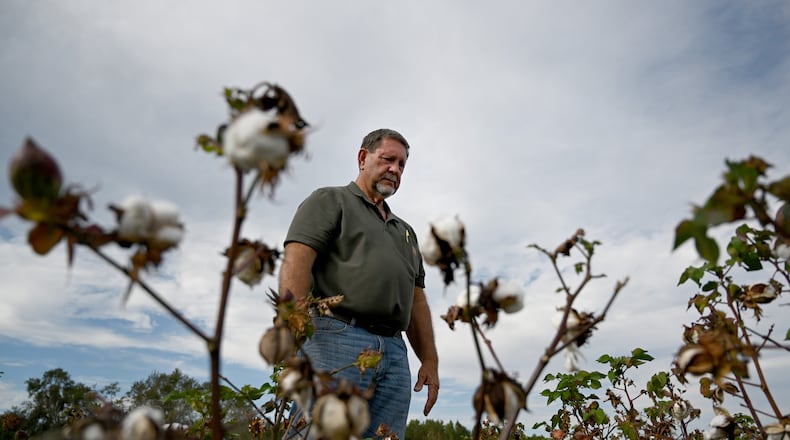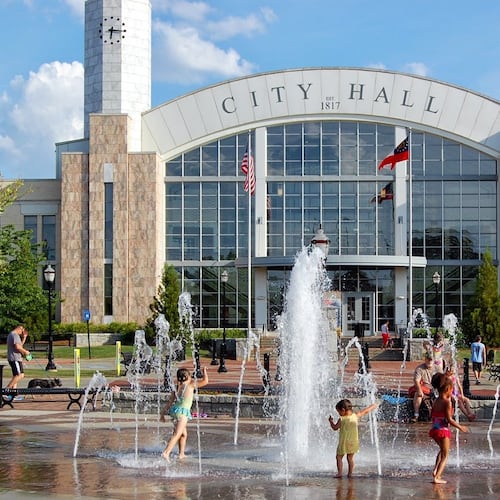The importance of Georgia’s two largest industries cannot be overstated. According to the Georgia Department of Economic Development, agriculture contributes more than $70 billion annually to the state and is its leading economic driver. The state’s timber industry leads the nation in several categories, including commercial acreage, harvest volume, product export value and seedling production. Per the Georgia Forestry Commission, it pumps more than $40 billion into the Peach State’s economy each year. Based on numbers from the state of Georgia and Georgia Forestry Association websites, these two industries together are responsible for more than 500,000 jobs.
Clearly, the businesses of growing and harvesting are essential to Georgia’s economy.
Credit: Handout
Credit: Handout
Credit: Handout
Credit: Handout
The Georgia Farm Bureau estimated the damage from Helene to the state’s timber and agriculture industries to be at least $6.4 billion. An increase in catastrophic storm damage from hurricanes like Helene and Milton complicates matters and has a ripple effect not just in this state but across the nation. As former state Rep. Chad Nimmer of Pierce Timber Co. told us recently, “This is going to be a generational reset for the timber industry.” Though he was referring to timber, this statement rings true for all of Georgia’s grower economies.
Timber is especially vulnerable to the vertical wind shear and straight-line winds found miles from the eye of an advancing hurricane. The Georgia Forestry Commission reported earlier last month that more than $1.2 billion in timber was felled by Helene alone and more than 8.8 million acres of timber were impacted. The downed timber, which might only be good for pulp depending on how fast it’s removed from the forest floor, quickly creates a glut in the timber market, driving down income for both growers and harvesters. It also creates scarcity in the milled timber markets, driving up costs for consumers.
Row crops such as pecans, blueberries and cotton were also hit hard. The Georgia Chamber estimated damages to these three commodities alone will approach $600 million. These valuable crops are susceptible to spoilage when farmland is inundated by floodwater. Depending on when a storm hits, blueberries and soybeans become unharvestable; slow-growing, mature pecan trees are downed; cotton boll fiber is ruined by moisture or defoliation; and peanuts rot in the ground, unable to adequately dry. For many growers, Georgia’s valuable second season is a complete loss.
Poultry farmers can be especially vulnerable, losing entire hen houses and the animals within a single storm. The Georgia Farm Bureau reported chicken farmers lost 800 houses and suffered between $500 and $520 million in damages as Helene cut a swath of damage from Valdosta to Augusta.
Damages to the infrastructure of farming and timber (buildings, equipment, seed stock, transportation networks, etc.) are simply not just “collateral damage”; they multiply a big storm’s disastrous effects and directly impact all Georgians.
Given timber’s lengthy cycle from seedling to shelf and relatively straightforward harvesting method, landowners do not typically need excess equipment or structures to maintain their stand. However, the timber industry’s crucial intermediaries — timber harvesters, haulers, etc. — are in a bind as they scramble to get timber that might or might not be processable off the forest floor and to a market with razor-thin margins.
Pecan, peanut, vegetable and fruit farms require specialized tractors, hauling vehicles, storage buildings and sheds of all sizes, as well as high-tech, high-end, technology-assisted machinery. Like their timber counterparts, the industries that support food and fiber’s journey to market are under enormous pressure to stay in operation. Storm damage directly impacts “input costs” — costs actually incurred before anything grows. An insurance premium is part of this. Increased input costs eventually drive up consumer costs.
Our own insurance practices are part of these “grower economies.” We rely on the agriculture and timber industries just as thousands of our fellow Georgians do. Our clients — growers and farmers and the folks that bring their products to market — are sophisticated businesspeople, and many have been working the same plots of land or small businesses for generations. Though these industries are changing through technological advances and consolidation, the overarching need to adequately mitigate risk and provide for loss coverage remains constant. Now, insurance professionals across the state are working with clients to reestablish a sense of normality.
We suggest that immediately after this cleanup, farmers pivot to a proactive stance and reevaluate their insurance needs. Many times, a farming operation will expand over the years with the addition of structures and additional equipment. Often, these additions are not recorded adequately. Each and every item should be accounted for, and an inventory maintenance program should be implemented to track upkeep on all structures, vehicles and equipment. Beyond crop coverage, operators should inspect and determine which pieces of their individual infrastructure need repair or replacement and which are worth insuring — or not. A close analysis and updating of replacement costs is also crucial. All these things can help reduce a key input cost: the insurance premium.
Timber-related businesses — timber dealers, logging contractors, log haulers and their various trading partners — are a key component of the timber industry. When a natural disaster destroys merchantable timber to this magnitude, those businesses are especially vulnerable. Most timber landowners do not have a way to insure their stands — not because they don’t want to, but because viable insurance products aren’t readily available as timber is not a part of the Federal Crop Insurance Program. Often, timber tracts are acquired and nurtured over decades. A grower might have one opportunity in his lifetime to complete a full seedling-to-harvest cycle. Storms like Helene are seemingly increasing in frequency, and their impact is felt far inland, away from typical landfall zones and dramatically impacting the timber harvest cycle. We advocate for a proactive, new way of thinking about risk mitigation and risk transfer strategies for an industry that is highly efficient and technologically advanced.
Creativity can help minimize losses across the board. All of these proactive steps come down to having what can be difficult conversations about potential loss and the value of property and operations. A thoughtful, thorough, systematic and professional review of an entire operation now can alleviate a grim conversation about coverage inadequacies in the wake of the next superstorm. Much like the hard work of getting a crop into the ground and nurturing its growth, so too can a proactive insurance posture help reap benefits in a time of loss.
Will Wilson and Sam Sports are principals at Oakbridge Insurance, specializing in proactive risk management and insurance solutions for Georgia’s timber and agriculture industries, respectively.
Keep Reading
The Latest
Featured




